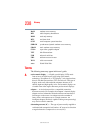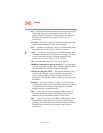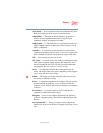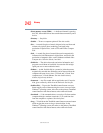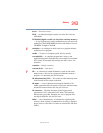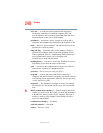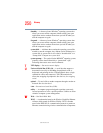
243
Glossary
5.375 x 8.375 ver 3.1
driver — See device driver.
DVD — An individual digital versatile (or video) disc. See also
DVD-ROM.
DVD-ROM (digital versatile [or video] disc read-only memory)
— A very high-capacity storage medium that uses laser optics for
reading data. Each DVD-ROM can hold as much data as several
CD-ROMs. Compare CD-ROM.
E
emulation — A technique in which a device or program imitates
another device or program.
enable — To turn on a computer option. See also disable.
executable file — A computer program that is ready to run.
Application programs and batch files are examples of executable
files. Names of executable files usually end with a .bat or .exe
extension.
extension — See file extension.
external device — See device.
F
file — A collection of related information, saved on disk with a
unique name. A file may be a program, information used by a
program, or a document. See also document.
file allocation table (FAT) — The section of a disk that keeps track
of the location of files stored on the disk.
file name — A set of characters that uniquely identifies a file
within a particular folder. It consists of two parts: the actual name
and the file name extension. See also file extension.
file extension — The three characters following the period
(pronounced “dot”) at the end of a file name. The extension
indicates the type of file. Examples are .exe for program files
and .hlp for help files. See also file name.
folder — Also called directory. A container for organizing files
saved to a disk. A folder is symbolized on screen by a graphical
image (icon) of a file folder. A folder can contain files and other
folders.






